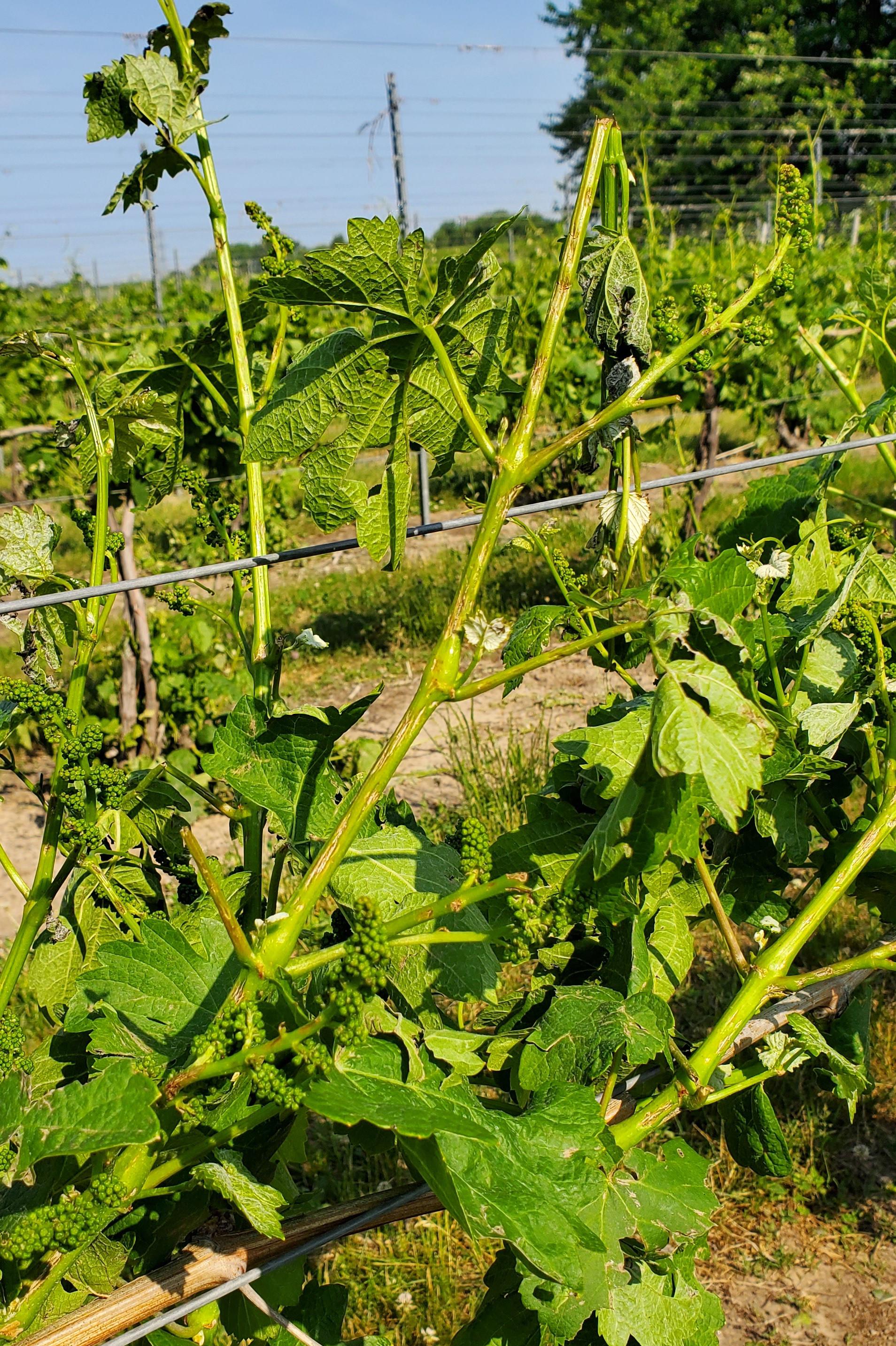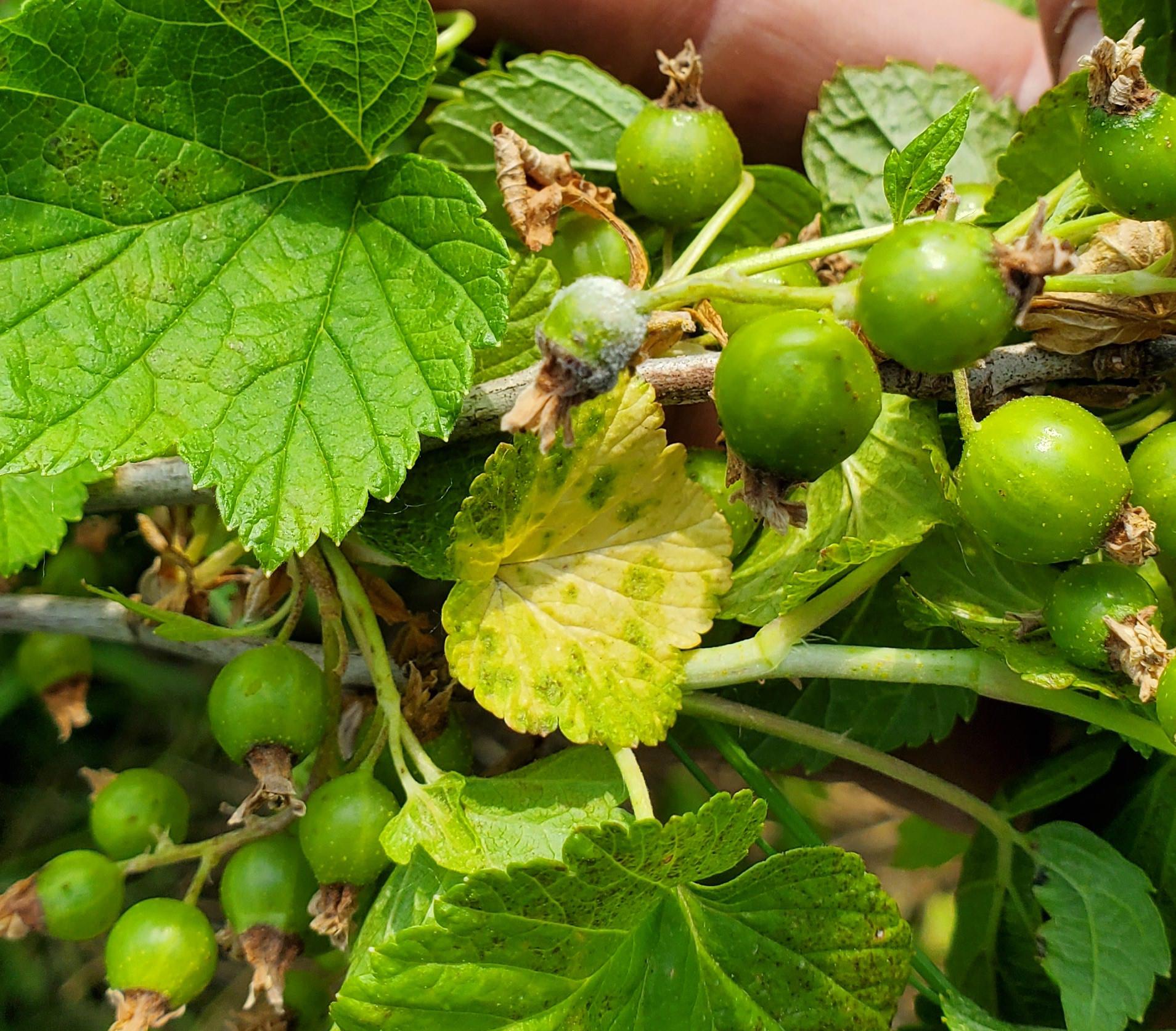Southwest Michigan fruit update – June 6, 2023
Strawberry harvest has begun. Others like sweet cherries are not far behind.

Weather
Low humidity and sunny skies dominated last week. Most days saw high temperatures near 90 degrees Fahrenheit. But with the low humidity, nighttime temperatures dropped close to 60 F. The hot, sunny weather created conditions for popup afternoon showers several days. They were scattered and did not result in much rain accumulation. Thursday was the most consistent. Monday, June 5, saw a drop in temperatures by about 10-15 F as the high pressure dome exited the area.
Weekly rain totals were generally less than a tenth of an inch with a couple sites recording up to a half inch. One isolated storm cell in central Berrien County near Baroda, Michigan, caused hail and wind damage to a few fruit crop properties.
We collected above average number of growing degree days (GDD) last week, 212 GDD base 42 and 156 GDD base 50, respectively. We have been drier than average for several weeks. Soils are dry.
|
Southwest Michigan GDD summary from March 1 – June 5, 2023 |
|||
|---|---|---|---|
|
Station |
GDD 42 F |
GDD 45 F |
GDD 50 F |
|
Benton Harbor (SWMREC) |
1015 |
844 |
608 |
|
Lawton (Lawton) |
1031 |
860 |
624 |
|
Fennville (TNRC) |
900 |
740 |
523 |
|
Average for the SW region |
989 |
821 |
593 |
|
Average last week |
777 |
630 |
437 |
The next week should continue the trend started on Monday. Expect to see high temperatures in the upper 70s most days with lows in the upper 50s. Again, very little rain is in the forecast. The only chance is on Saturday evening through Sunday.
Most showers will not result in any relief for the soils or plants but may be enough to splash disease spores in the vineyards and orchards. Expect soils to stay dry. Irrigation may be needed in the coming week for young plantings and sandy sites.

Tree fruit
June drop of tree fruit is underway. Lack of water is increasingly becoming a problem, especially for young trees. Fawns are old enough now to travel with mothers, increasing the potential for damage on tree fruit plantings. Aphids of various types on several tree fruit types are increasing under dry conditions. Insect activity is continuing to increase with warm weather. Tarnished plant bug or other piercing mouthpiece insects have been actively damaging fruit. Plum curculio egglaying should be on the decline, but feeding damage by this insect will continue.
Apricot fruit are sizing well, fruit diameter exceeding 35 mm, with hand thinning needed in some locations. Brown rot protection will be needed as fruit start to color.
Peach and nectarine fruit size is averaging about 30 mm, with June drop still occurring. Hand thinning has begun on some farms. Tarnished plant bug and plum curculio damage is common in some sites. Shoot flagging due to first generation oriental fruit moth larvae is showing up now. Bacterial spot symptoms on leaf tips are slowly increasing on susceptible varieties. Cover sprays for peach scab run from petal fall to third cover and from shuck split to pit hardening for rusty spot (powdery mildew) for susceptible varieties.
Cherry Montmorency fruit are averaging 13 mm and are starting to show a hint of straw color. Ethrel treatment for improvement of fruit color and easier mechanical harvest is timed for full straw color to early red. Crop potential for the area is still good, but reportedly less than full in west central and northwest Michigan. Sweet cherry fruit are starting to turn red, with some farms anticipating some harvest of early varieties next week.
Cherry leafspot symptoms are slowly increasing. Two infection periods have been predicted so far for cherry leafspot for this year for central Berrien County, compared to eight in 2022 and six in 2021 for the same time period. Brown rot treatment is needed as fruit start to turn red.
In plum, the largest European plum fruit (Stanley and Castleton) are approximately 20 mm in diameter. Japanese plum Shiro is averaging 25 mm.
Apple fruit range from 22 mm to 30 mm, depending on the variety and location. Fruit drop due to thinning sprays and natural June drop is underway. Rescue thinning with ethrel and Accede are the only chemical options now, with less prospects for success with fruit of this size. Summer NAA treatment for encouragement of return bloom usually begins about five weeks after full bloom, with additional spray treatments at seven and nine weeks after full bloom. The next rain should deplete the overwintering scab ascospore supply.
Little or no fire blight symptoms have been seen in the area due to dry conditions. Hail last Thursday in the Baroda area of Berrien County could trigger a surge of fire blight. Sooty blotch and flyspeck development has been slowed by dry conditions although dews can help these pathogens. Insects of concern are leafrollers, oriental fruit moth and codling moth. Biofix for codling moth is approximately May 18 for the area. Rosy apple aphid and green apple aphids can be found in the area.
Pear (Bartlett and Harrow Sweet) fruit range from 21 to 25 mm diameter at the Southwest Michigan Research and Extension Center in Berrien County. June drop is underway. Pear rust is appearing on leaves. This disease can be rather spectacular in appearance. Pear psylla nymphs and adults are common on leaves and fruit in some orchards.
Small fruit
Grapes are blooming. Juice grapes are in the middle or late bloom. Early hybrids are finishing while some later hybrids are just beginning. The first signs of vinifera bloom have been seen, but widespread bloom is likely a week or more away.
Wild grape bloom has been recorded throughout southwest Michigan. Reports from grape producing areas in central Berrien County started coming in on May 25. Growers in Van Buren and Allegan counties started reporting sightings two days later on May 27. Wild grape bloom is used as a biofix for grape berry moth. Biofix is when 50% of clusters are at 50% bloom. See this article for more information: Using the MSU Enviroweather grape berry moth model in 2018.
With the rain expected this weekend, a bloom or immediate prebloom fungicide application should be on grape growers’ minds. Black rot and phomopsis infections have been seen. Likely from the small amount of rain the region saw about three weeks ago. These signs can be infection sources for any spore dispersal in the weekend’s rains. Once bloom is visible, focus should expand to include the spring concerns and the bunch rots: phomopsis, black rot, anthracnose, downy mildew, botrytis bunch rot and powdery mildew. No powdery mildew has been reported at this time, but with the warm, dry weather we have been seeing the last few weeks, we are expecting it. Other crops are reporting powdery mildew infections.
Blueberry bloom has finished. Many varieties are already showing green fruit. Growers have begun thinking about berry rot sprays.
Strawberry harvest is underway from southern Berrien County up through northern Van Buren County. Growers are still thinking about fruit rot sprays. Cranberry and cherry fruitworms are flying and laying eggs now. Cover sprays to manage these moths should be out or going out soon.
Brambles bloom is underway for summer bearing raspberries throughout southwest Michigan. Blackberries are starting to bloom as well. Raspberry sawfly damage has been reported.
Currant and gooseberry harvest expectations are looking good. These crops are not generally a concern in our area for many diseases or insect pests, but powdery mildew can be a problem under the right conditions. With the warm, dry weather the past few weeks, powdery mildew is becoming visible in some plantings.

Announcements
Our regular southwest Monday fruit IPM updates are once again a hybrid format. The meetings are held in-person with virtual attending also available online. Our first meeting was Monday, April 10, at 5:30 p.m. and will continue through the rest of the season. You need to register to receive the Zoom link and password for these meetings. The webinars are free and one pesticide applicator credit is available for each meeting. The same Zoom link will be used with all the Monday meetings—you only need to register once.
There will be a virtual Blueberry Season Update from 12-1 p.m. tomorrow, June 7.
If you’d like more blueberry information in your inbox, sign up for Blueberry Bites! New this year, Blueberry Bites is a blueberry-focused, bite-sized, weekly update from the blueberry team at MSU.
This work is supported by the Crop Protection and Pest Management Program [grant no 2021-70006-35450] from the USDA National Institute of Food and Agriculture. Any opinions, findings, conclusions, or recommendations expressed in this publication are those of the author(s) and do not necessarily reflect the view of the U.S. Department of Agriculture.



 Print
Print Email
Email
